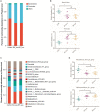Comparison of the effects of rumen-protected and unprotected L-leucine on fermentation parameters, bacterial composition, and amino acids metabolism in in vitro rumen batch cultures
- PMID: 38075859
- PMCID: PMC10701908
- DOI: 10.3389/fmicb.2023.1282767
Comparison of the effects of rumen-protected and unprotected L-leucine on fermentation parameters, bacterial composition, and amino acids metabolism in in vitro rumen batch cultures
Abstract
This study was conducted to compare the effects of rumen-protected (RP-Leu) and unprotected L-leucine (RU-Leu) on the fermentation parameters, bacterial composition, and amino acid metabolism in vitro rumen batch incubation. The 5.00 g RP-Leu or RU-Leu products were incubated in situ in the rumen of four beef cattle (Bos taurus) and removed after 0, 2, 4, 6, 12, 16, and 24 h to determine the rumen protection rate. In in vitro incubation, both RP-Leu and RU-Leu were supplemented 1.5 mmol/bottle (L-leucine HCl), and incubated after 0, 2, 4, 6, 8, 12, and 16 h to measure gas production (GP), nutrient degradability, fermentation parameters, bacterial composition, and amino acids metabolism. Results from both in vitro and in situ experiments confirmed that the rumen protection rate was greater (p < 0.01) in RP-Leu than in RU-Leu, whereas the latter was slow (p < 0.05) degraded within incubation 8 h. Free leucine from RP-Leu and RU-Leu reached a peak at incubation 6 h (p < 0.01). RU-Leu supplementation increased (p < 0.05) gas production, microbial crude protein, branched-chain AAs, propionate and branched-chain VFAs concentrations, and Shannon and Sobs index in comparison to the control and RP-Leu supplementation. RU-Leu and RP-Leu supplementation decreased (p < 0.05) the relative abundance of Bacteroidota, which Firmicutes increased (p < 0.05). Correlation analysis indicated that there are 5 bacteria at the genus level that may be positively correlated with MCP and propionate (p < 0.05). Based on the result, we found that RP-Leu was more stable than RU-Leu in rumen fluid, but RU-Leu also does not exhibit rapid degradation by ruminal microbes for a short time. The RU-Leu was more beneficial in terms of regulating rumen fermentation pattern, microbial crude protein synthesis, and branched-chain VFAs production than RP-Leu in vitro rumen conditions.
Keywords: L-leucine; bacterial community; beef cattle; in vitro technique; rumen fermentation; rumen protection rate.
Copyright © 2023 An, Shen, Liu, Yang, Chen, Yuan, Li, Xiao, Wang, Lan, Liu and Wan.
Conflict of interest statement
The authors declare that the research was conducted in the absence of any commercial or financial relationships that could be construed as a potential conflict of interest.
Figures








References
-
- AOAC (1995). Official methods of analysis. Association of Official Analytical Chemists: Arlington, VA.
LinkOut - more resources
Full Text Sources
Miscellaneous

